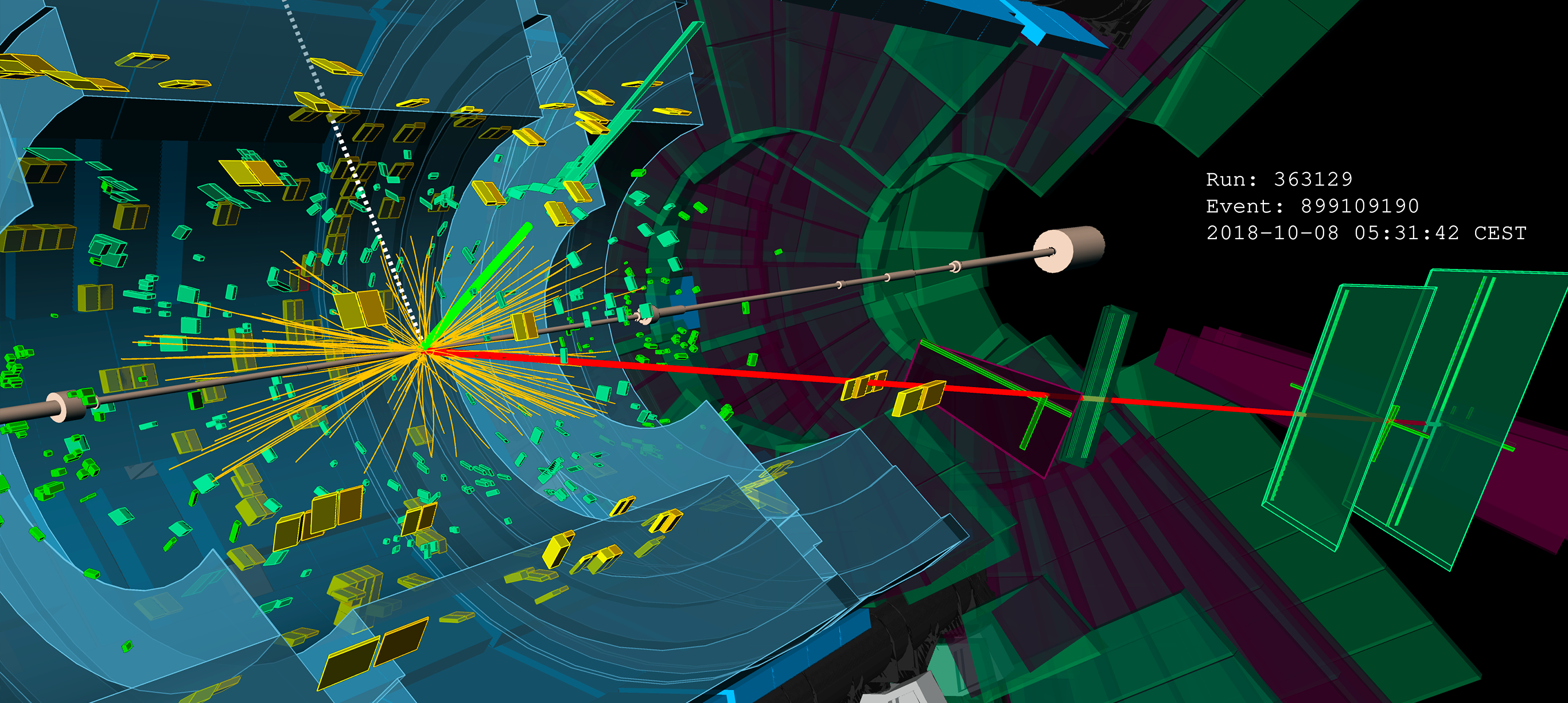Measuring the delicate balance of lepton flavours
25 March 2024 | By
In a new result presented at the Moriond EW conference, physicists at the ATLAS Collaboration tested lepton flavour universality between muons and electrons. The precision of the result stands as the best yet-achieved in W-boson decays by a single experiment and surpasses the world average.
Most elementary particles can be categorised into groups or families with similar properties. For example, the lepton family includes the electron (e), which forms the negatively charged cloud of particles surrounding the nucleus in every atom; the muon (μ), a heavier particle found in cosmic rays; and the tau (𝜏), an even heavier short-lived particle only seen in high-energy particle interactions. As far as physicists know, the only difference between these particles is their mass. In particular, a remarkable feature of the Standard Model is that each flavour is equally likely to interact with a W boson, a carrier particle of the weak force. This is known as lepton flavour universality.
If lepton flavour universality holds, the chances of a W boson decaying into an electron, a muon or a tau should be the same. Thus, their measured production ratios should be equal to unity.
High-precision tests of lepton flavour universality – as obtained by comparing the decay rates of the W boson into an electron, muon or tau, and their corresponding neutrinos – are therefore sensitive probes of physics beyond the Standard Model. Indeed, if lepton flavour universality holds, they should be equal (within negligible, mass-dependent corrections). This can be tested by measuring ratios of the W-boson decay probabilities into the different lepton flavours, such as R(μ/e) or R(𝜏/μ). A challenge of such measurements at a hadron collider is the collection of an unbiased sample of W bosons. In a paper released by Nature Physics in 2021, in which the ATLAS Collaboration reported the world’s most precise measurement of the ratio of W bosons decaying into taus vs muons (R(𝜏/μ)), physicists demonstrated that collisions events with top-quark pairs provide an abundant and clean sample of W bosons.
In their latest paper, ATLAS physicists measured the ratio of the W boson decaying into muons vs electrons ( R(μ/e)). While the combination of all previous measurements showed that this ratio is within about 0.6% of unity (corresponding to equal decay probabilities to muons and electrons), there was still room for improvement. The new ATLAS result studied the full LHC Run 2 dataset (collected 2015-2018). The analysis looked at over 100 million top-quark-pair events produced in the ATLAS experiment. As the top quark decays promptly to a W boson and a bottom quark (Wb), this sample provides 100 million events, each with two W bosons. By counting the number of events with two electrons (and no muons), or two muons (and no electrons), physicists can test whether the W boson decays more often into electrons (giving more ee and fewer μμ events), or to muons (giving more μμ and fewer ee).
However, it's not that simple! The Z boson can also decay into a pair of electrons or muons, leaving a similar experimental signature. Since the invariant mass (mee or mμμ) of the leptons in these events clusters around the Z-boson mass of 91 GeV, this background process can be estimated and subtracted (see Figure 1).

As a result of measurements conducted in the 1990s at CERN’s Large Electron-Positron (LEP) collider and the Stanford Linear Collider (SLC), the corresponding ratio for Z bosons (comparing Z→μμ and Z→ee decays) is known to be equal to unity within 0.3%. Thus, in this ATLAS analysis, the Z ratio was determined as a reference measurement, allowing researchers to reduce uncertainties coming from the reconstruction of electrons and muons. Additionally, as many measurement uncertainties are similar in the ee and μμ final states, they were found to have only a minor effect on the ratio R(μ/e).
The final result from this new ATLAS analysis is R(μ/e)=0.9995 ± 0.0045, perfectly compatible with unity. The result has a uncertainty of only 0.45%, which is more precise than all previous measurements combined (see Figure 2). Any deviation of R(μ/e) from unity would hint for new interactions and particles to play a role in the decay of the W boson to leptons, a tell-tale of physics beyond the Standard Model. But for now, lepton flavour universality survives intact.
Learn more
- Precise test of lepton flavour universality in W-boson decays into muons and electrons in proton-proton collisions at 13 TeV with the ATLAS detector (arXiv:2403.02133, see figures)
- Moriond EW 2024 presentation by Andrea Knue: Precise test of lepton flavour universality in W boson decays into muons and electrons in proton-proton collisions at 13 TeV with the ATLAS detector
- Test of the universality of τ and μ lepton couplings in W-boson decays with the ATLAS detector (Nature Phys. 17 (2021) 813, arXiv:2007.14040, see figures)
- Summary of new ATLAS results from Moriond 2024, ATLAS News, March 2024
- LHC passes a new milestone as a precision machine, ATLAS Physics Briefing, March 2023
- New ATLAS result addresses long-standing tension in the Standard Model, ATLAS Physics Briefing, May 2020
- See also the full list of ATLAS physics results.





